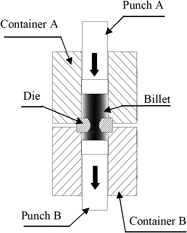Crossref Citations
This article has been cited by the following publications. This list is generated based on data provided by
Crossref.
Erturun, V.
and
Karamis, M. B.
2018.
The Influences of Reciprocating Extrusion Passes on the Microstructure Properties of Al 6061/SiC Composites.
Powder Metallurgy and Metal Ceramics,
Vol. 56,
Issue. 11-12,
p.
617.
Çelik, Yahya Hışman
Demir, Mehmet Emin
Kilickap, Erol
and
Kalkanli, Ali
2020.
Investigation of wear behavior of aged and non-aged SiC-reinforced AlSi7Mg2 metal matrix composites in dry sliding conditions.
Journal of the Brazilian Society of Mechanical Sciences and Engineering,
Vol. 42,
Issue. 1,
Erturun, Veysel
Çetin, Sezer
and
Sahin, Oguzhan
2021.
Investigation of Microstructure of Aluminum Based Composite Material Obtained by Mechanical Alloying.
Metals and Materials International,
Vol. 27,
Issue. 6,
p.
1662.
Gogaev, K.O.
Voropaev, V.S.
Podrezov, Yu. M.
Yevych, Ya. I.
and
Mazur, P.V.
2021.
The Effect of Rolling Conditions on the Properties of Aluminum Powder Composites Reinforced by Sic, Tic, and AIB12 Nanoparticles.
Powder Metallurgy and Metal Ceramics,
Vol. 60,
Issue. 1-2,
p.
35.
Msebawi, Muntadher Sabah
Leman, Zulkiflle
Shamsudin, Shazarel
Tahir, Suraya Mohd
Jaafar, Che Nor Aiza
Ariff, Azmah Hanim Mohamed
Zahari, Nur Ismarrubie
and
Rady, Mohammed H.
2021.
The Effects of CuO and SiO2 on Aluminum AA6061 Hybrid Nanocomposite as Reinforcements: A Concise Review.
Coatings,
Vol. 11,
Issue. 8,
p.
972.
Bond, T.
Badmos, A.
Ahmed, R.A.
Obayemi, J.D.
Salifu, A.
Rahbar, N.
and
Soboyejo, W.O.
2022.
Indentation size effects in aluminum and titanium alloys.
Materials Science and Engineering: A,
Vol. 839,
Issue. ,
p.
142542.
Hanish Anand, S.
Venkateshwaran, N.
Sai Prasanna Kumar, J. V.
Kumar, D.
Ramesh Kumar, C.
and
Maridurai, T.
2022.
Optimization of Aging, Coating Temperature and Reinforcement Ratio on Biosilica Toughened in-situ Al-TiB2 Metal Matrix Composite: a Taguchi Grey Relational Approach.
Silicon,
Vol. 14,
Issue. 8,
p.
4337.
Rajesh, R.
Shankar, Balakrishnan
Rajeev, Amal Krishna
Govind, V.
Shankar, Karthik V.
George, Nibin
and
Vijay, Rishikesh
2023.
Morphological, Hardness, and Wear Behavior of Cu–Sn–SiC Metal Matrix Composite Developed by Microwave Processing.
Transactions of the Indian Institute of Metals,
Vol. 76,
Issue. 9,
p.
2401.
Sarath Chandra, K.
and
Sarkar, Debasish
2023.
Nanoscale reinforcement efficiency analysis in Al2O3–MgO–C refractory composites.
Materials Science and Engineering: A,
Vol. 865,
Issue. ,
p.
144613.
Jayaseelan, Veerasundaram
Kalaichelvan, Kani
Ramasamy, Nallamuthu
and
Seeman, Murugesan
2023.
Influence of SiCp volume percentage on AA6063/SiCp MMC extrusion process: An experimental, theoretical and simulation analysis.
International Journal of Lightweight Materials and Manufacture,
Vol. 6,
Issue. 3,
p.
357.
Suresh, N
Balamurugan, L
and
Jayabalakrishnan, D
2023.
Influence of SiC and WC reinforcements on the mechanical characteristics of AA6061 hybrid metal matrix composites.
Proceedings of the Institution of Mechanical Engineers, Part E: Journal of Process Mechanical Engineering,
Vol. 237,
Issue. 3,
p.
955.
Erturun, Veysel
and
Ozbay, Eyyup
2024.
Effect of Zn amount on AlZn-based composite material produced by high speed mechanical alloying method.
Aircraft Engineering and Aerospace Technology,
Vol. 96,
Issue. 10,
p.
1295.



